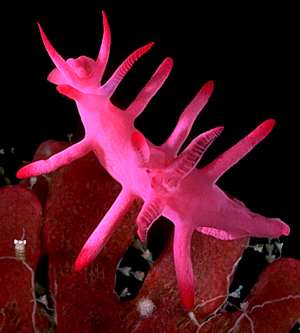

Okenia hallucigenia
Rudman, 2004
Order: NUDIBRANCHIA
Suborder: DORIDINA
Superfamily: ANADORIDOIDEA
Family: Goniodorididae
DISTRIBUTION
Northern Australia from Western Australia (Kimberley, Exmouth Gulf), Northern Territory, Queensland, central New South Wales.
PHOTO
Upper: on bryozoan food colony, Pleurotoichus clathratus, Halifax Park, Port Stephens, New South Wales, July 1986. 18mm long. AM C150357. Photo: Bill Rudman. Lower: SEM of radula showing part of whole ribbon (upper) and section of left side of ribbon (lower) showing large denticulate inner teeth and small reduced, plate-like outer teeth. North Solitary Is., Coffs Harbour, New South Wales, Australia, 17 January 1989, AM C157164. Scale bar = 10 µm. Photos: A.C. Miller.
NOTE: This species has previously been called Hopkinsia sp. on the Forum.
The animal is very elongate with a high profile and completely lacks any sign of a mantle edge. There are 4 prominent, very large, lateral papillae on each side of the body. The anterior papilla on each side sits in front of the adjacent rhinophore, and points forward. It is somewhat smaller than the 3 other lateral papillae on each side which point outwards and somewhat upwards. They are quite rigid and so are not as mobile and flexible as the papillae of many other species of Okenia with long papilla. There is one other mantle papilla, and it sits in the dorsal midline, just in front of the gills. There are up to 5 simple gills arranged in arch around the anal papilla. The rhinophores are long and tapering. The club, with up to 16 lamellae, occupies the upper two-thirds of the rhinophore. The head is very distinctive, with a wide bilobed 'oral veil' at least twice the width of the body. At times the lateral tips of the head can extend into tentacular foot corners. This species is named for its superficial likeness to the Burgess Shale 'onycophoran' fossil, Hallucigenia sparsa Morris, 1977, as reconstructed by Lars Ramsköld (1992). The whole of the animal is bright pink except for the tips of the mantle processes, the gills, and the rhinophores which are a deeper, redder shade of the same colour.
The radula is very similar in shape to that of O. kondoi. The inner teeth have a broad base and a blade which ends in a bicuspid tip. A medio-dorsal groove runs down the distal half of the tooth. There are up to 16 very long denticles along the cutting edge of the tooth. The much smaller outer teeth have a broadly quadrangular shape with up to 3 or 4 remnant cusps.
Okenia hallucigenia is often found with the very similar looking Okenia stellata on the bryozoan Pleurotoichus clathratus. This pair of species is matched by another pair of similarly shaped and coloured species (O. nakanotoensis, O. kondoi) which are reported from southern Japan, the Marshall Ids and the Philippines. Okenia kondoi is very similar to Okenia hallucigenia in external shape and radular morphology. Externally, O. kondoi appears to be even more cylindrical in shape than O. hallucigenia, its diameter matching that of the cylindrical branches of the bryozoan on which it lives and feeds. It also differs from O. hallucigenia in its colour pattern, with the bottom half of each papilla being creamy white. Okenia hallucigenia differs from O. stellata in the number of lateral papillae, radular morphology, and details of colour pattern. Observations from Western Australia, Queensland and New South Wales all note its association with the bryozoan Pleurotoichus clathratus.
-
Rudman, W.B. (2004) Further species of the opisthobranch genus Okenia (Nudibranchia: Goniodorididae) from the Indo-West Pacific. Zootaxa, 695: 1-70
Rudman, W.B., 2004 (December 21) Okenia hallucigenia Rudman, 2004. [In] Sea Slug Forum. Australian Museum, Sydney. Available from http://www.seaslugforum.net/find/okenhall
Related messages
Re: Okenia hallucigenia from sthn Queensland
November 11, 2008
From: Gary Cobb
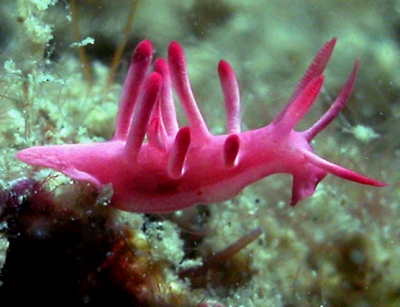
Concerning message #22022:
Hi Bill and everyone!
Attached is another local Okenia hallucigenia and egg mass. The animal in the photo alongside [black background] laid the egg mass. The colour of the mass is always the same colour, an orangey-pink. The two photos you have now are ventral views!
Locality: Mooloolaba, Sunshine Coast, 12 m, Queensland, Australia, Pacific Ocean, 31 December 2005, Subtidal. Length: 13 mm. Photographer: Gary Cobb and David Mullins.
I have not seen O. atkinsonorum or O. stellata here yet. We will spend more time on the reef systems at the north end of Moreton Island, no telling what we'll find.
Cheers Gary
gary@nudibranch.com.au
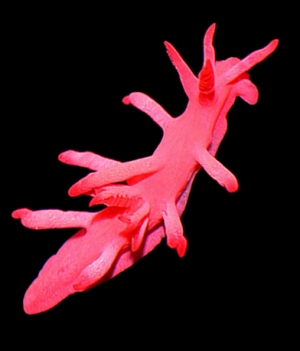

Dear Gary,
Thanks for the quick follow up. From your photos, the egg mass of this species seems to be a more transparent colour than the very opaque pinkish colour of O. atkinsonorum [see #21274; #9320]. Although the diameter of the total egg ribbon seems to be similar in both species, the actual ribbon in O. hallucigenia appears narrower, and there seem to be fewer eggs. It would be great to see a photo of the egg ribbon in the field.
Best wishes,
Bill Rudman
Okenia hallucigenia from sthn Queensland
November 10, 2008
From: Gary Cobb
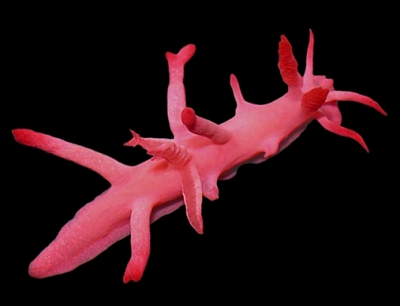

Concerning message #22019:
Hi Bill and everyone!
Well again here another entry to the World Famous Sea Slug Forum! Here are some photos of Okenia hallucigenia from "our backyard".
Locality: Mooloolaba, Sunshine Coast, 15 m, Queensland, Australia, Pacific Ocean, 24 November 2007, Subtidal. Length: 15-22 m. Photographer: Gary Cobb.
Cheers
Gary
gary@nudibranch.com.au
Cobb, G.C., 2008 (Nov 10) Okenia hallucigenia from sthn Queensland. [Message in] Sea Slug Forum. Australian Museum, Sydney. Available from http://www.seaslugforum.net/find/22022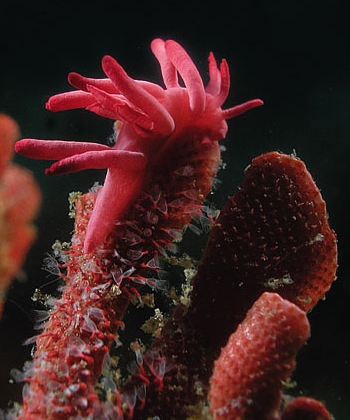
Dear Gary,
Thanks for these photos. Although the animal in the upper photos looks a bit damaged we can still see the characteristic 4 pairs of dorso-lateral papillae. Thanks also for the photo of the egg ribbon, which I have not seen before. Are the eggs always this colour or do they start out white? Do you see either of the other pink species [O. atkinsonorum, O. stellata] which eat the same bryozoan?
The photo of O. hallucigenia on its food, Pleurotoichus clathratus, nicely shows the extended polyp-like zooids. It would be interesting to know just how each of the three species that eat this bryozoan bite off the zooids, as each species has quite differently shaped teeth.
Best wishes,
Bill Rudman
Okenia hallucigenia ? from Port Stephens
November 7, 2008
From: Leanne & David Atkinson
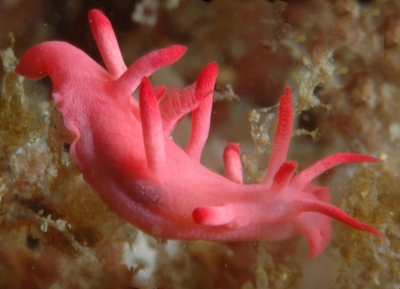
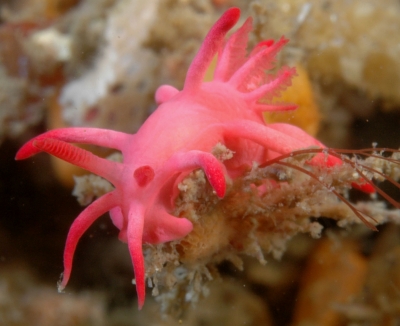
Hi Bill,
We think we found Okenia hallucigenia at Halifax at the weekend. There were three individuals close together. They seemed longer and higher bodied than our usual Okenia atkinsonorum. The oral veil seemed much more pointed. Have we identified them correctly or are they just H. atkinsonorum stretched out?
Locality: Halifax Sponge Gardens, Port Stephens-Great Lakes Marine Park, Port Stephens, 14 metres, New South Wales, Australia, Pacific, 02 November 2008, Sandy bottom sponges, bryozoans, soft corals, hydroids and ascidians. Length: 15 mm. Photographer: Leanne & David Atkinson.
Regards,
Leanne & David Atkinson
atk@hunterlink.net.au
Atkinson, L. & D., 2008 (Nov 7) Okenia hallucigenia ? from Port Stephens. [Message in] Sea Slug Forum. Australian Museum, Sydney. Available from http://www.seaslugforum.net/find/22019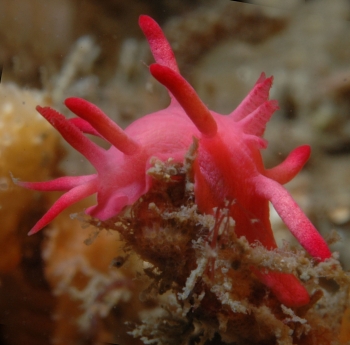
Dear Leanne & David,
You are quite right. This is O. hallucigenia. I had begun to wonder what had happened to this species in the Port Stephens area, because in all your years of observing you have only photographed O. atkinsonorum. In fact we have no records on the Forum of this species from anywhere. This species is characterised externally by the strange 'oral veil' at the front of the body and the regular 4 pairs of lateral papillae down the body. It will be interesting to see if it will maintain a permanent population in the Port Stephens area or whether it is a tropical species with larvae that only rarely travel and successfully settle this far south. It would be interesting to see what sort of egg ribbon it lays.
Best wishes,
Bill Rudman
Hopkinsia feeding on Pleurotoichus
August 26, 1999
From: Phil Bock
Another image (by Julie Marshall) can be found on the Bryozoa pages: at http://www.civgeo.rmit.edu.au/bryozoa/cheilostomatida/euthyrisellidae/pleucla.html
Phil Bock
(ex RMIT)
now Deakin University
pbock@deakin.edu.au
